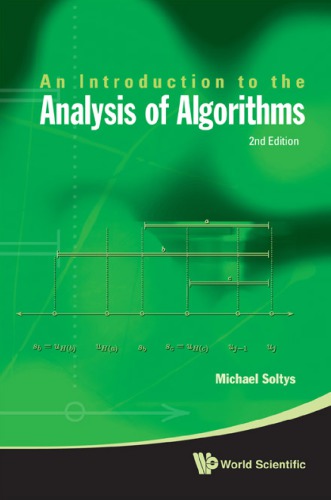

Most ebook files are in PDF format, so you can easily read them using various software such as Foxit Reader or directly on the Google Chrome browser.
Some ebook files are released by publishers in other formats such as .awz, .mobi, .epub, .fb2, etc. You may need to install specific software to read these formats on mobile/PC, such as Calibre.
Please read the tutorial at this link. https://ebooknice.com/page/post?id=faq
We offer FREE conversion to the popular formats you request; however, this may take some time. Therefore, right after payment, please email us, and we will try to provide the service as quickly as possible.
For some exceptional file formats or broken links (if any), please refrain from opening any disputes. Instead, email us first, and we will try to assist within a maximum of 6 hours.
EbookNice Team

Status:
Available4.5
16 reviews
ISBN 10: 9814401153
ISBN 13: 9789814401159
Author: Michael Soltys
A successor to the first edition, this updated and revised book is a great companion guide for students and engineers alike, specifically software engineers who design reliable code. While succinct, this edition is mathematically rigorous, covering the foundations of both computer scientists and mathematicians with interest in algorithms.Besides covering the traditional algorithms of Computer Science such as Greedy, Dynamic Programming and Divide & Conquer, this edition goes further by exploring two classes of algorithms that are often overlooked: Randomised and Online algorithms -- with emphasis placed on the algorithm itself. The coverage of both fields are timely as the ubiquity of Randomised algorithms are expressed through the emergence of cryptography while Online algorithms are essential in numerous fields as diverse as operating systems and stock market predictions.While being relatively short to ensure the essentiality of content, a strong focus has been placed on self-containment, introducing the idea of pre/post-conditions and loop invariants to readers of all backgrounds. Containing programming exercises in Python, solutions will also be placed on the book's website.
1. Preliminaries
1.1 Induction
1.2 Invariance
1.3 Correctness of algorithms
1.3.1 Division algorithm
1.3.2 Euclid's algorithm
1.3.3 Palindromes algorithm
1.3.4 Further examples
1.3.5 Recursion and fixed points
1.3.6 Formal verification
1.4 Stable marriage
1.5 Answers to selected problems
1.6 Notes
2. Greedy Algorithms
2.1 Minimum cost spanning trees
2.2 Jobs with deadlines and profits
2.3 Further examples and problems
2.3.1 Make change
2.3.2 Maximum weight matching
2.3.3 Shortest path
2.3.4 Huffman codes
2.4 Answers to selected problems
2.5 Notes
3. Divide and Conquer
3.1 Mergesort
3.2 Multiplying numbers in binary
3.3 Savitch's algorithm
3.4 Further examples and exercises
3.4.1 Extended Euclid's algorithm
3.4.2 Finite automaton
3.5 Answers to selected problems
3.6 Notes
4. Dynamic Programming
4.1 Longest monotone subsequence problem
4.2 All pairs shortest path problem
4.2.1 Bellman-Ford algorithm
4.3 Simple knapsack problem
4.3.1 Dispersed knapsack problem
4.3.2 General knapsack problem
4.4 Activity selection problem
4.5 Jobs with deadlines, durations and profits
4.6 Further examples and problems
4.6.1 Consecutive subsequence sum problem
4.6.2 Regular expressions
4.6.3 Context free grammars
4.7 Answers to selected problems
4.8 Notes
5. Online Algorithms
5.1 List accessing problem
5.2 Paging
5.2.1 Demand paging
5.2.2 FIFO
5.2.3 LRU
5.2.4 Marking algorithms
5.2.5 FWF
5.2.6 LFD
5.3 Answers to selected problems
5.4 Notes
an introduction to the analysis of algorithms pdf
an introduction to the analysis of shotgun metagenomic data
an introduction to the structural analysis of narrative
an introduction to the composition and analysis of greek prose
windows to the world an introduction to literary analysis
Tags: Michael Soltys, An Introduction, the Analysis of Algorithms